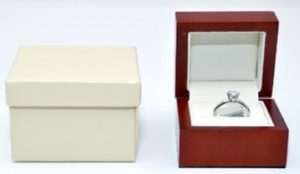Costco Has Been Saved by the Fair Use Defense: $21 Million Tiffany Award Reversed
In a huge break for Costco Wholesale Corp. (“Costco”), the U.S. Court of Appeals for the Second Circuit in New York recently reversed a $21 million trademark infringement award in favor of famed jeweler Tiffany & Co. (“Tiffany”), giving Costco the opportunity to argue that its use of the word “Tiffany” on small point of sale signs was lawful as a “fair use.”[1]
The facts of the case are straight forward. Between 2007 and 2012, Costco sold diamond engagement rings that were neither designed, manufactured, nor supplied by Tiffany. The rings were sold in unbranded standalone displays bearing small white point of sale signs with black type that contained the word “Tiffany” along with the item number and the price of the item, as follows:
While Tiffany argued that Costco salespeople referred to the rings as the “Tiffany” when speaking with customers, Costco explained that this reference was based upon the six-pronged diamond ring setting, referred to in the jewelry industry as the “Tiffany setting.” This setting was originally designed by Charles Lewis Tiffany in the late nineteenth century.
To be sure, nothing about the Costco rings or their packaging resembled Tiffany-branded merchandise in any way. Costco did not use the stylized Tiffany name or logo, and rather than Tiffany’s iconic turquoise packaging, the Costco rings were sold in plain non-descript brown and beige packaging
Costco’s proof of fair use– which was apparently ignored by the lower court — was compelling and supported the claim that for more than 100 years the term “Tiffany” had been used repeatedly and persistently to refer to the Tiffany setting.[2] The evidence comprised advertisements, trade publications, and dictionaries, including Webster’s Third New International Dictionary of the English Language (2002), which defined “Tiffany” as an “adjective meaning ‘of a jewelry setting: having long prongs to hold a gem’.”[3]
The proof also included Tiffany references by diamond ring suppliers and top industry publications, including the Dictionary of Gems and Gemology (Springer Verlag 3d ed. 2009), the Diamond Dictionary (GIA 3d ed. 1993), the Jewelers’ Dictionary (JCK 3d ed. 1976), and The Jewelers’ Manual (GIA 1967).[4]
The fair use defense to trademark infringement is available where an alleged infringer uses the protected word or design (1) other than as a distinctive trademark, (2) in a descriptive sense, and (3) in good faith.[5] SLG believes that Costco’s fair use arguments are sound.
The case has been sent back to the lower court in the Southern District of New York, which must provide Costco with the opportunity to present its fair use arguments at trial. SLG will be following the lower court’s next moves and will provide updates as new information becomes available.[6]
This case reinforces the tenet that “the public’s right to use descriptive words or images in good faith in their ordinary descriptive sense . . . prevail[s] over the exclusivity claims of . . . trademark owner[s].”[7]
SLG has extensive experience advising clients on trademark, trade dress, fair use, and related intellectual property matters. We would be happy to assist your company navigate the possible pitfalls presented by these and other issues. For more information, please contact SLG at info@shelgroup.com.
[1] Tiffany & Co. v. Costco Wholesale Corp., 2020 U.S. App. LEXIS 25957 (2d Cir. Aug. 17, 2020).
[2] Id. at *4 – 5.
[3] Def.’s Mem. Supp. Summ. J. 4, May 22, 2014, ECF No. 122.
[4] Id. at 5.
[5] See 15 U.S.C. § 1115(b)(4).
[6] In addition to fair use, the appeals court also noted that Tiffany should prove the existence of consumer confusion — the touchstone of trademark infringement — which requires evidence that customers truly believed that Costco was marketing actual Tiffany products and not the generic products actually being sold.
[7] Tiffany & Co., 2020 U.S. App. LEXIS 25957, at 36 (internal quotes and citations omitted).








